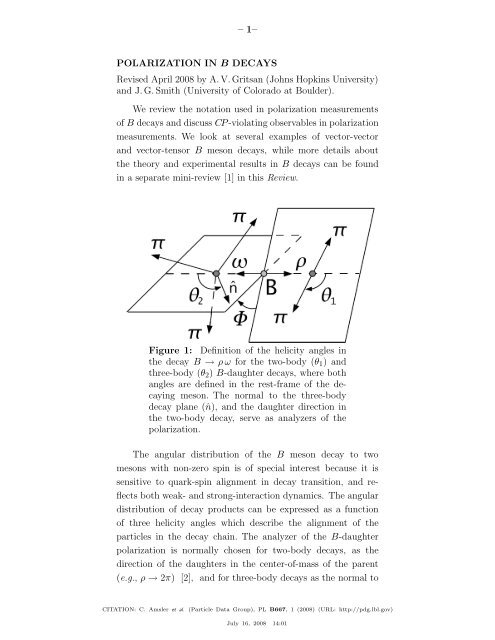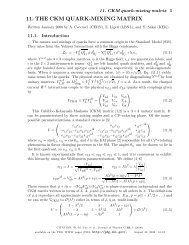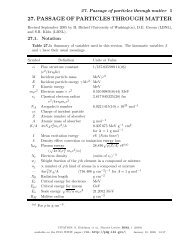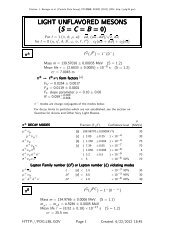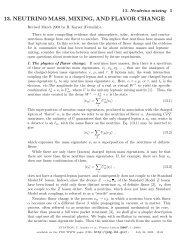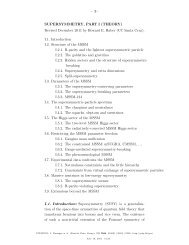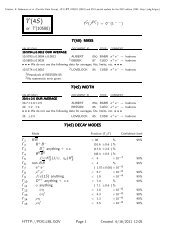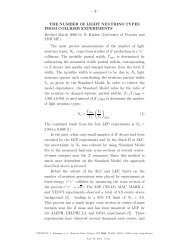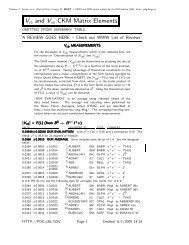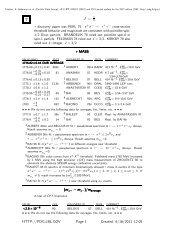Polarization in B Decays - Particle Data Group
Polarization in B Decays - Particle Data Group
Polarization in B Decays - Particle Data Group
Create successful ePaper yourself
Turn your PDF publications into a flip-book with our unique Google optimized e-Paper software.
–1–<br />
POLARIZATION IN B DECAYS<br />
Revised April 2008 by A. V. Gritsan (Johns Hopk<strong>in</strong>s University)<br />
and J. G. Smith (University of Colorado at Boulder).<br />
We review the notation used <strong>in</strong> polarization measurements<br />
of B decays and discuss CP -violat<strong>in</strong>g observables <strong>in</strong> polarization<br />
measurements. We look at several examples of vector-vector<br />
and vector-tensor B meson decays, while more details about<br />
the theory and experimental results <strong>in</strong> B decays can be found<br />
<strong>in</strong> a separate m<strong>in</strong>i-review [1] <strong>in</strong> this Review.<br />
Figure 1: Def<strong>in</strong>ition of the helicity angles <strong>in</strong><br />
the decay B → ρω for the two-body (θ 1 )and<br />
three-body (θ 2 ) B-daughter decays, where both<br />
angles are def<strong>in</strong>ed <strong>in</strong> the rest-frame of the decay<strong>in</strong>g<br />
meson. The normal to the three-body<br />
decay plane (ˆn), and the daughter direction <strong>in</strong><br />
the two-body decay, serve as analyzers of the<br />
polarization.<br />
The angular distribution of the B meson decay to two<br />
mesons with non-zero sp<strong>in</strong> is of special <strong>in</strong>terest because it is<br />
sensitive to quark-sp<strong>in</strong> alignment <strong>in</strong> decay transition, and reflects<br />
both weak- and strong-<strong>in</strong>teraction dynamics. The angular<br />
distribution of decay products can be expressed as a function<br />
of three helicity angles which describe the alignment of the<br />
particles <strong>in</strong> the decay cha<strong>in</strong>. The analyzer of the B-daughter<br />
polarization is normally chosen for two-body decays, as the<br />
direction of the daughters <strong>in</strong> the center-of-mass of the parent<br />
(e.g., ρ → 2π) [2], and for three-body decays as the normal to<br />
CITATION: C. Amsler et al.<br />
(<strong>Particle</strong> <strong>Data</strong> <strong>Group</strong>), PL B667, 1 (2008) (URL: http://pdg.lbl.gov)<br />
July 16, 2008 14:01
–2–<br />
the decay plane [3] (see Fig. 1). An equivalent set of transversity<br />
angles is sometimes used <strong>in</strong> polarization analyses [4]. The<br />
differential decay width depends on complex amplitudes A λ ,<br />
correspond<strong>in</strong>g to the B-daughter helicity states λ.<br />
Most B-decay polarization analyses are limited to the case<br />
when the sp<strong>in</strong> of one of the B-meson daughters is 1. In that case,<br />
there are only three <strong>in</strong>dependent amplitudes correspond<strong>in</strong>g to<br />
λ =0or±1 [5], where the last two can be expressed <strong>in</strong> terms of<br />
parity-even and parity-odd amplitudes A ‖,⊥ =(A +1 ±A −1 )/ √ 2.<br />
The overall decay amplitude would <strong>in</strong>volve three complex terms<br />
proportional to the above amplitudes and the d functions of<br />
helicity angles. The exact angular dependence would depend<br />
on the quantum numbers of the B-meson daughters and of<br />
their decay products, and can be found <strong>in</strong> the literature [5,6].<br />
The differential decay rate would <strong>in</strong>volve six real quantities α i ,<br />
<strong>in</strong>clud<strong>in</strong>g <strong>in</strong>terference terms,<br />
dΓ<br />
Γ d cos θ 1 d cos θ 2 dΦ = ∑ i<br />
α i f i (cos θ 1 , cos θ 2 ,Φ) , (1)<br />
where each f i (cos θ 1 , cos θ 2 ,Φ) has unique angular dependence<br />
specific to particle quantum numbers, and the α i parameters<br />
are def<strong>in</strong>ed as:<br />
α 1 = |A 0| 2<br />
Σ|A λ | 2 = f L , (2)<br />
α 2 = |A ‖| 2 + |A ⊥ | 2<br />
Σ|A λ | 2 =(1− f L ) , (3)<br />
α 3 = |A ‖| 2 −|A ⊥ | 2<br />
Σ|A λ | 2 =(1− f L − 2 f ⊥ ) , (4)<br />
α 4 = Im(A ⊥A ∗ ‖ )<br />
Σ|A λ | 2 = √ f ⊥ (1−f L −f ⊥ )s<strong>in</strong>(φ ⊥ −φ ‖ ) , (5)<br />
α 5 = Re(A ‖A ∗ 0 )<br />
Σ|A λ | 2 = √ f L (1 − f L − f ⊥ )cos(φ ‖ ) , (6)<br />
α 6 = Im(A ⊥A ∗ 0 )<br />
Σ|A λ | 2 = √ f ⊥ f L s<strong>in</strong>(φ ⊥ ) , (7)<br />
where the amplitudes have been expressed with the help of<br />
polarization parameters f L , f ⊥ , φ ‖ ,andφ ⊥ def<strong>in</strong>ed <strong>in</strong> Table 1.<br />
Note that the terms proportional to Re(A ⊥ A ∗ ‖ ), Im(A ‖A ∗ 0 ),<br />
and Re(A ⊥ A ∗ 0 ) are absent <strong>in</strong> Eqs. (2-7). However, these terms<br />
July 16, 2008 14:01
–3–<br />
may appear <strong>in</strong> some cases of the three-body decay of a B-meson<br />
daughter, see Ref. 6.<br />
Table 1: Rate, polarization, and CP -asymmetry<br />
parameters def<strong>in</strong>ed for the B-meson decays to<br />
mesons with non-zero sp<strong>in</strong>. Numerical examples<br />
are shown for the B 0 → ϕK ∗ (892) 0 decay. The<br />
first six parameters are def<strong>in</strong>ed under the assumption<br />
of no CP violation <strong>in</strong> decay, while<br />
they are averaged between the B and B parameters<br />
<strong>in</strong> general. The last six parameters<br />
<strong>in</strong>volve differences between the B and B meson<br />
decay parameters. The phase convention δ 0<br />
is chosen with respect to a s<strong>in</strong>gle A 00 amplitude<br />
from a reference B decay mode, which is<br />
B 0 → ϕK0 ∗(1430)0 for numerical results.<br />
parameter def<strong>in</strong>ition average<br />
B Γ/Γ total (9.5 ± 0.8) × 10 −6<br />
f L |A 0 | 2 /Σ|A λ | 2 0.484 ± 0.033<br />
f ⊥ |A ⊥ | 2 /Σ|A λ | 2 0.26 ± 0.04<br />
φ ‖ − π arg(A ‖ /A 0 ) − π −0.81 ± 0.14<br />
φ ⊥ − π arg(A ⊥ /A 0 ) − π −0.81 ± 0.14<br />
δ 0 − π arg(A 00 /A 0 ) − π −0.36 ± 0.19<br />
A CP (¯Γ − Γ)/(¯Γ+Γ) −0.01 ± 0.06<br />
A 0 CP<br />
A ⊥ CP<br />
( ¯ f L − f L )/( ¯ f L + f L ) +0.02 ± 0.07<br />
( ¯ f ⊥ − f ⊥ )/( ¯ f ⊥ + f ⊥ ) −0.11 ± 0.12<br />
∆φ ‖ ( ¯φ ‖ − φ ‖ )/2 +0.10 ± 0.24<br />
∆φ ⊥ ( φ ¯ ⊥ − φ ⊥ − π)/2 +0.04 ± 0.23<br />
∆δ 0 ( ¯δ 0 − δ 0 )/2 +0.21 ± 0.19<br />
Overall, six real parameters describe three complex amplitudes<br />
A 0 , A ‖ ,andA ⊥ . These could be chosen to be the four<br />
polarization parameters f L , f ⊥ , φ ‖ , and φ ⊥ , one overall size<br />
normalization, such as decay rate Γ, or branch<strong>in</strong>g fraction B,<br />
and one overall phase δ 0 . The phase convention is arbitrary for<br />
an isolated B decay mode. However, for several B decays, the<br />
relative phase could produce mean<strong>in</strong>gful and observable effects<br />
through <strong>in</strong>terference with other B decays with the same f<strong>in</strong>al<br />
July 16, 2008 14:01
–4–<br />
states, such as for B → VKJ ∗ with J =0, 1, 2, 3, 4, ... The phase<br />
could be referenced to the s<strong>in</strong>gle B → VK0 ∗ amplitude A 00<br />
<strong>in</strong> such a case, as shown <strong>in</strong> Table 1. Here V stands for any<br />
sp<strong>in</strong>-one vector meson.<br />
Moreover, CP violation can be tested <strong>in</strong> the angular distribution<br />
of the decay as the difference between the B and<br />
B. Each of the six real parameters describ<strong>in</strong>g the three complex<br />
amplitudes would have a counterpart CP -asymmetry term,<br />
correspond<strong>in</strong>g to three direct-CP asymmetries <strong>in</strong> three amplitudes,<br />
and three CP -violat<strong>in</strong>g phase differences, equivalent to<br />
the phase measurements from the mix<strong>in</strong>g-<strong>in</strong>duced CP asymmetries<br />
<strong>in</strong> the time evolution of the B-decays [1]. In Table 1 and<br />
Ref. 7, these are chosen to be the direct-CP asymmetries <strong>in</strong> the<br />
overall decay rate A CP ,<strong>in</strong>thef L fraction A 0 CP ,and<strong>in</strong>thef ⊥<br />
fraction A ⊥ CP<br />
, and three weak phase differences:<br />
∆φ ‖ = 1 2 arg(Ā‖A 0 /A ‖ Ā 0 ) , (8)<br />
∆φ ⊥ = 1 2 arg(Ā⊥A 0 /A ⊥ Ā 0 ) − π 2 , (9)<br />
∆δ 0 = 1 2 arg(Ā00A 0 /A 00 Ā 0 ) . (10)<br />
The π 2 term <strong>in</strong> Eq. (9) reflects the fact that A ⊥ and Ā⊥ differ<br />
<strong>in</strong> phase by π if CP is conserved. The two parameters ∆φ ‖ and<br />
∆φ ⊥ are equivalent to triple-product asymmetries constructed<br />
from the vectors describ<strong>in</strong>g the decay angular distribution [8].<br />
The CP -violat<strong>in</strong>g phase difference <strong>in</strong> the reference decay mode<br />
is, <strong>in</strong> the Wolfenste<strong>in</strong> CKM quark-mix<strong>in</strong>g phase convention,<br />
∆φ 00 = 1 2 arg(A 00/Ā00) . (11)<br />
This can be measured only together with the mix<strong>in</strong>g-<strong>in</strong>duced<br />
phase difference for some of the neutral B-meson decays similar<br />
to other mix<strong>in</strong>g-<strong>in</strong>duced CP asymmetry measurements [1].<br />
It may not always be possible to have a phase-reference<br />
decay mode which would def<strong>in</strong>e δ 0 and ∆δ 0 parameters. In that<br />
case, it may be possible to def<strong>in</strong>e the phase difference directly<br />
similarly to Eq. (11):<br />
∆φ 0 = 1 2 arg(A 0/Ā0) . (12)<br />
July 16, 2008 14:01
–5–<br />
One can measure the angles of the CKM unitarity triangle,<br />
assum<strong>in</strong>g Standard Model contributions to the ∆φ 0 and B-<br />
mix<strong>in</strong>g phases. Examples <strong>in</strong>clude measurements of β = φ 1 with<br />
B → J/ψK ∗ and α = φ 2 with B → ρρ.<br />
Most of the B decays that arise from tree-level b → c<br />
transitions have the amplitude hierarchy |A 0 | > |A + | > |A − |<br />
which is expected from analyses based on quark-helicity conservation<br />
[9]. The larger the mass of the vector-meson daughters,<br />
the weaker the <strong>in</strong>equality. The B meson decays to heavy vector<br />
particles with charm, such as B → J/ψK ∗ , ψ(2S)K ∗ , χ c1 K ∗ ,<br />
D ∗ ρ, D ∗ K ∗ , D ∗ D ∗ , and D ∗ Ds ∗ , show a substantial fraction<br />
of the amplitudes correspond<strong>in</strong>g to transverse polarization of<br />
the vector mesons (A ±1 ), <strong>in</strong> agreement with the factorization<br />
prediction. The detailed amplitude analysis of the B → J/ψK ∗<br />
decays has been performed by the BABAR [10], Belle [11],<br />
CDF [12], and CLEO [13] collaborations. Most analyses are<br />
performed under the assumption of the absence of direct CP<br />
violation. The parameter values are given <strong>in</strong> the particle list<strong>in</strong>g<br />
of this Review. The difference between the strong phases<br />
φ ‖ and φ ⊥ deviates significantly from zero. The recent measurements<br />
[10,11] of CP -violat<strong>in</strong>g terms similar to those <strong>in</strong><br />
B → ϕK ∗ [7] shown <strong>in</strong> Table 1 are consistent with zero.<br />
In addition, the mix<strong>in</strong>g-<strong>in</strong>duced CP -violat<strong>in</strong>g asymmetry is<br />
measured <strong>in</strong> the B 0 → J/ψK ∗0 decay [1,10,11] where angular<br />
analysis allows one to separate CP -eigenstate amplitudes. This<br />
allows one to resolve the sign ambiguity of the cos 2β =cos2φ 1<br />
term that appears <strong>in</strong> the time-dependent angular distribution<br />
due to <strong>in</strong>terference of parity-even and parity-odd terms. This<br />
analysis relies on the knowledge of discrete ambiguities <strong>in</strong> the<br />
strong phases φ ‖ and φ ⊥ , as discussed below. The BABAR<br />
experiment used a novel method based on the dependence on<br />
the Kπ <strong>in</strong>variant mass of the <strong>in</strong>terference between the S- and<br />
P -waves to resolve the discrete ambiguity <strong>in</strong> the determ<strong>in</strong>ation<br />
of the strong phases (φ ‖ ,φ ⊥ )<strong>in</strong>B → J/ψK ∗ decays [10]. The<br />
result is <strong>in</strong> agreement with the amplitude hierarchy expectation<br />
[9]. The CDF [12] and D0 [14] experiments have studied<br />
the Bs 0 → J/ψϕ decay and provided the lifetime, polarization,<br />
and phase measurements.<br />
July 16, 2008 14:01
–6–<br />
The amplitude hierarchy |A 0 |≫|A + |≫|A − | was expected<br />
<strong>in</strong> the B decays to light vector particles <strong>in</strong> both the pengu<strong>in</strong><br />
transition [15,16] and the tree-level transition [9]. There<br />
is confirmation by BABAR and BELLE experiments of predom<strong>in</strong>antly<br />
longitud<strong>in</strong>al polarization <strong>in</strong> the tree-level b → u<br />
transition, such as B 0 → ρ + ρ − [17], B + → ρ 0 ρ + [18], and<br />
B + → ωρ + [19], which is consistent with the analysis of the<br />
quark helicity conservation [9]. Because the longitud<strong>in</strong>al amplitude<br />
dom<strong>in</strong>ates the decay, a detailed amplitude analysis is not<br />
possible with current B samples, and limits on the transverse<br />
amplitude fraction are obta<strong>in</strong>ed. Only limits have been set on<br />
the B 0 → ωρ 0 ,ωω [19] and evidence found for B 0 → ρ 0 ρ 0 [20]<br />
decays, still <strong>in</strong>dicat<strong>in</strong>g that b → d pengu<strong>in</strong> pollution is small <strong>in</strong><br />
the charmless, strangeless vector-vector B decays.<br />
The <strong>in</strong>terest <strong>in</strong> the polarization and CP -asymmetry measurements<br />
<strong>in</strong> pengu<strong>in</strong> transition, such as b → s decays B →<br />
ϕK ∗ , ρK ∗ , ωK ∗ , or Bs<br />
0 → ϕϕ, and b → d decay B →<br />
K ∗ ¯K∗ , is ma<strong>in</strong>ly motivated by their potential sensitivity to<br />
physics beyond the Standard Model. The decay amplitudes<br />
for B → ϕK ∗ have been measured by the BABAR and<br />
Belle experiments [7,21,22]. The fractions of longitud<strong>in</strong>al polarization<br />
f L =0.50 ± 0.05 for the B + → ϕK ∗+ decay, and<br />
f L =0.484 ± 0.033 for the B 0 → ϕK ∗0 decay, <strong>in</strong>dicate significant<br />
departure from the naive expectation of predom<strong>in</strong>ant<br />
longitud<strong>in</strong>al polarization, and suggest other contributions to the<br />
decay amplitude, previously neglected, either with<strong>in</strong> the Standard<br />
Model, such as pengu<strong>in</strong> annihilation [24] or QCD rescatter<strong>in</strong>g<br />
[25], or from physics beyond the Standard Model [26]. The<br />
complete set of twelve amplitude parameters measured <strong>in</strong> the<br />
B 0 → ϕK ∗0 decay are given <strong>in</strong> Table 1. Several other parameters<br />
could be constructed from the above twelve parameters, as<br />
suggested <strong>in</strong> Ref. 27.<br />
The discrete ambiguity <strong>in</strong> the phase (φ ‖ ,φ ⊥ ,∆φ ‖ ,∆φ ⊥ )<br />
measurements has been resolved by BABAR <strong>in</strong> favor of |A + |≫<br />
|A − | through <strong>in</strong>terference between the S- andP -waves of Kπ.<br />
The search for vector-tensor B → ϕKJ ∗ decays with J =2, 3, 4<br />
revealed a large fraction of longitud<strong>in</strong>al polarization <strong>in</strong> the<br />
decay B → ϕK2 ∗(1430) with f L =0.85 ± 0.08 [7,28].<br />
July 16, 2008 14:01
–7–<br />
Like B → ϕK ∗ , the decays B → ρK ∗ and B → ωK ∗ may<br />
be sensitive to New Physics. Measurements of the longitud<strong>in</strong>al<br />
polarization fraction <strong>in</strong> B + → ρ 0 K ∗0 and B + → ρ + K ∗0 [29]<br />
reveal a polarization anomaly similar to B → ϕK ∗ .Atthesame<br />
time, first measurement of the polarization <strong>in</strong> the b → d pengu<strong>in</strong><br />
decay B 0 → K ∗0 ¯K∗0 <strong>in</strong>dicates a large fraction of longitud<strong>in</strong>al<br />
polarization f L =0.81<br />
−0.13 +0.12 [30]. There is also evidence for the<br />
Bs 0 → ϕϕ decay [31].<br />
The three-body smileptonic B-meson decays, such as B →<br />
Vl 1 l 2 , share many features with the two-body B → VV decays.<br />
Their differential decay width can be parameterized with the<br />
two helicity angles def<strong>in</strong>ed <strong>in</strong> the V and (l 1 l 2 ) frames and with<br />
the azimuthal angle, as def<strong>in</strong>ed <strong>in</strong> Fig. 1. However, s<strong>in</strong>ce the<br />
(l 1 l 2 ) pair does not come from an on-shell particle, the angular<br />
distribution is unique to each po<strong>in</strong>t <strong>in</strong> the dilepton mass<br />
m ll spectrum. The polarization measurements as a function of<br />
m ll provide complementary <strong>in</strong>formation on physics beyond the<br />
Standard Model, as discussed for B → K ∗ l + l − decay <strong>in</strong> Ref. 32,<br />
though the current data <strong>in</strong> this mode [33] are not yet sufficient<br />
for precise tests.<br />
The examples of the angular distributions and observables<br />
<strong>in</strong> B → K ∗ l + l − are discussed <strong>in</strong> Ref. 32. With the present<br />
statistics only two angular observables have been measured <strong>in</strong><br />
this decay when <strong>in</strong>tegrated over certa<strong>in</strong> ranges of the dilepton<br />
mass m ll [33]. One parameter is the fraction of longitud<strong>in</strong>al<br />
polarization F L , which is determ<strong>in</strong>ed by the K ∗ angular distribution<br />
and is similar to f L def<strong>in</strong>ed for exclusive two-body<br />
decays. The other parameter is the forward-backward asymmetry<br />
of the lepton pair A FB , which is the asymmetry of the decay<br />
rate with positive and negative values of cos θ 1 .<br />
In summary, there has been considerable recent <strong>in</strong>terest <strong>in</strong><br />
the polarization measurements of B-meson decays because they<br />
reveal both weak- and strong-<strong>in</strong>teraction dynamics [24–26,34].<br />
New measurements will further elucidate the pattern of sp<strong>in</strong><br />
alignment measurements <strong>in</strong> rare B decays, and further test the<br />
Standard Model and strong <strong>in</strong>teraction dynamics, <strong>in</strong>clud<strong>in</strong>g the<br />
non-factorizable contributions to the B-decay amplitudes.<br />
July 16, 2008 14:01
–8–<br />
References<br />
1. Y. Kwon and G. Punzi, “Production and Decay of b-<br />
Flavored Hadrons,” m<strong>in</strong>i-review <strong>in</strong> this Review.<br />
2. M. Jacob and G. C. Wick, Ann. Phys. 7, 404 (1959).<br />
3. S. M. Berman and M. Jacob, Phys. Rev. 139, 1023 (1965).<br />
4. I. Dunietz et al., Phys.Rev.D43, 2193 (1991).<br />
5. G. Kramer and W. F. Palmer, Phys. Rev. D45, 193<br />
(1992).<br />
6. A. Datta et al., arXiv:0711.2107 [hep-ph].<br />
7. BABAR Collaboration, B. Aubert et al., Phys. Rev. Lett.<br />
93, 231804 (2004); Phys. Rev. Lett. 98, 051801 (2007).<br />
8. G. Valencia, Phys. Rev. D39, 3339 (1998);<br />
A. Datta and D. London, Int. J. Mod. Phys. A19, 2505<br />
(2004).<br />
9. A. Ali et al., Z.PhysikC1, 269 (1979);<br />
M. Suzuki, Phys. Rev. D64, 117503 (2001).<br />
10. BABAR Collaboration, B. Aubert et al., Phys.Rev.D71,<br />
032005 (2005); Phys. Rev. D76, 031102 (2007).<br />
11. Belle Collaboration, R. Itoh et al., Phys. Rev. Lett. 95,<br />
091601 (2005).<br />
12. CDF Collaboration, T. Affolder et al., Phys. Rev. Lett.<br />
85, 4668 (2000); CDF Collaboration, D. Acosta et al.,<br />
Phys. Rev. Lett. 94, 101803 (2005).<br />
13. CLEO Collaboration, C. P. Jessop, Phys. Rev. Lett. 79,<br />
4533 (1997).<br />
14. D0 Collaboration, V. M. Abazov et al., Phys. Rev. Lett.<br />
98, 121801 (2007).<br />
15. H. Y. Cheng and K. C. Yang, Phys. Lett. B511, 40<br />
(2001);<br />
C. H. Chen, Y. Y. Keum, and H. n. Li, Phys. Rev. D66,<br />
054013 (2002).<br />
16. A. L. Kagan, Phys. Lett. B601, 151 (2004);<br />
Y.Grossman,Int.J.Mod.Phys.A19, 907 (2004).<br />
17. Belle Collaboration, A. Somov et al., Phys. Rev. Lett. 96,<br />
171801 (2006); BABAR Collaboration, B. Aubert et al.,<br />
Phys. Rev. D76, 052007 (2007).<br />
18. Belle Collaboration, J. Zhang et al., Phys. Rev. Lett. 91,<br />
221801 (2003); BABAR Collaboration, B. Aubert et al.,<br />
Phys. Rev. Lett. 97, 261801 (2006).<br />
19. BABAR Collaboration, B. Aubert et al., Phys.Rev.D74,<br />
051102 (2006).<br />
July 16, 2008 14:01
–9–<br />
20. BABAR Collaboration, B. Aubert et al., Phys. Rev. Lett.<br />
98, 111801 (2007).<br />
21. Belle Collaboration, K. F. Chen et al., Phys. Rev. Lett.<br />
94, 221804 (2005).<br />
22. BABAR Collaboration, B. Aubert et al., Phys. Rev. Lett.<br />
99, 201802 (2007).<br />
23. BABAR Collaboration, B. Aubert et al., Phys. Rev. Lett.<br />
91, 171802 (2003); Belle Collaboration, K. F. Chen et al.,<br />
Phys. Rev. Lett. 91, 201801 (2003).<br />
24. A. L. Kagan, Phys. Lett. B601, 151 (2004); H. n. Li and<br />
S. Mishima, Phys. Rev. D71, 054025 (2005); C.-H. Chen<br />
et al., Phys.Rev.D72, 054011 (2005); M. Beneke et al.,<br />
Phys. Rev. Lett. 96, 141801 (2006); C.-H. Chen and C.-Q.<br />
Geng, Phys. Rev. D75, 054010 (2007); A. Datta et al.,<br />
Phys. Rev. D76, 034015 (2007).<br />
25. C. W. Bauer et al., Phys. Rev. D70, 054015 (2004);<br />
P. Colangelo et al., Phys. Lett. B597, 291 (2004); M. Ladisa<br />
et al., Phys.Rev.D70, 114025 (2004); H. Y. Cheng et al.,<br />
Phys. Rev. D71, 014030 (2005).<br />
26. Y. Grossman, Int. J. Mod. Phys. A 19, 907 (2004); E. Alvarez<br />
et al., Phys.Rev.D70, 115014 (2004); P. K. Das and<br />
K. C. Yang, Phys. Rev. D71, 094002 (2005); C. H. Chen<br />
andC.Q.Geng,Phys.Rev.D71, 115004 (2005); Y. D. Yang<br />
et al., Phys.Rev.D72, 015009 (2005); K. C. Yang, Phys.<br />
Rev. 72, 034009 (2005); S. Baek,Phys. Rev. D72, 094008<br />
(2005); C. S. Huang et al., Phys.Rev.D73, 034026 (2006);<br />
C. H. Chen and H. Hatanaka, Phys. Rev. D73, 075003<br />
(2006); A. Faessler et al., Phys.Rev.D75, 074029 (2007).<br />
27. D. London, N. S<strong>in</strong>ha, and R. S<strong>in</strong>ha, Phys. Rev. D69,<br />
114013 (2004).<br />
28. BABAR Collaboration, B. Aubert et al., Phys.Rev.D76,<br />
051103 (2007).<br />
29. Belle Collaboration, J. Zhang et al., Phys. Rev. Lett. 95,<br />
141801 (2005); BABAR Collaboration, B. Aubert et al.,<br />
Phys. Rev. Lett. 97, 201801 (2006).<br />
30. BABAR Collaboration, B. Aubert et al., arXiv:0708.2248<br />
[hep-ex].<br />
31. CDF Collaboration, D. Acosta et al., Phys. Rev. Lett. 95,<br />
031801 (2005).<br />
32. G. Burdman, Phys. Rev. D52, 6400 (1995); F. Kruger and<br />
J. Matias, Phys. Rev. D71, 094009 (2005); E. Lunghi and<br />
J. Matias, JHEP 0704, 058 (2007).<br />
July 16, 2008 14:01
– 10–<br />
33. Belle Collaboration, A. Ishikawa et al., Phys. Rev. Lett.<br />
96, 251801 (2006); BABAR Collaboration, B. Aubert<br />
et al., Phys.Rev.D73, 092001 (2006).<br />
34. C. H. Chen and H. n. Li, Phys. Rev. D71, 114008 (2005).<br />
July 16, 2008 14:01


